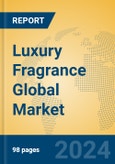Market Size and Growth Forecast
The global luxury fragrance market is estimated at USD 1.5 billion to USD 1.7 billion in 2025, with a CAGR of 5% to 6% from 2025 to 2030, reaching USD 2 billion to USD 2.3 billion by 2030.Regional Analysis
Europe dominates with 30-40%, growing at 4.5-5.5%, led by France, trending toward artisanal scents. North America holds 30-35%, growing at 5.0-6%, with the U.S. focusing on premium retail, leaning toward personalization. Asia Pacific grows at 6.0-7%, with 20-25% share, led by China, trending toward luxury gifting. MEA grows at 5.5-6.5%, with 5-10% share, emphasizing status symbols. South America grows at 4.0-5%, with 1-2% share, focusing on niche markets.Application Analysis
Specialty stores lead with 75-80%, growing at 4.5-5.5%, driven by exclusivity, with trends in experiential retail. Online stores account for 10-15%, growing at 6.5-7.5%, focusing on convenience, with trends in e-commerce growth. Others hold 5-10%, growing at 4.0-5%, with niche trends.Product Type Analysis
Women dominate with 65-70%, growing at 5.0-6%, valued for variety, with trends in floral scents. Men account for 25-30%, growing at 5.0-6%, focusing on bold notes, with trends in woody profiles. Unisex holds 5-10%, growing at 5.5-6.5%, with trends in versatile, niche offerings.Key Market Players
- Dior (LVMH): A French icon crafting timeless luxury fragrances.
- L'Oréal: A French giant delivering premium scent innovations.
- Chanel: A French titan shaping elegance in fragrance design.
- Coty: A U.S. leader enhancing luxury scent portfolios.
- Estee Lauder: A U.S. firm crafting sophisticated fragrance experiences.
- Inter Parfums: A U.S. expert optimizing niche luxury scents.
- EuroItalia: An Italian specialist advancing artisanal fragrances.
- Natura &Co (Avon): A Brazilian innovator blending luxury with sustainability.
- Hermès: A French maestro delivering exclusive scent artistry.
- Revlon: A U.S. pioneer shaping accessible luxury fragrances.
- Creed: A UK titan crafting heritage-rich scent masterpieces.
- Elizabeth Arden: A U.S. firm enhancing feminine fragrance allure.
- Baccarat: A French expert merging crystal with luxury scents.
- Nichebox: An Italian leader advancing bespoke fragrance solutions.
Porter’s Five Forces Analysis
- Threat of New Entrants: Medium. High brand barriers deter entry, but demand lowers hurdles for niche players.
- Threat of Substitutes: Medium. Mass-market scents compete, yet luxury branding sustains its edge.
- Bargaining Power of Buyers: High. Consumers demand exclusivity and quality, leveraging options.
- Bargaining Power of Suppliers: Medium. Ingredient suppliers hold influence, but large players diversify sourcing.
- Competitive Rivalry: High. Firms compete on branding, quality, and innovation, driving advancements.
- Impact of Tariff Conflicts on Supply Chain Localization
Market Opportunities and Challenges
Opportunities
- Wealth growth: Rising affluence drives demand, aligning with luxury trends.
- Digital retail: E-commerce boosts accessibility, offering growth.
- Niche scents: Unique offerings enhance appeal, tapping into premium markets.
- Emerging markets: Luxury spending in Asia Pacific fuels demand, leveraging gifting culture.
Challenges
- High costs: Premium ingredients limit affordability, challenging penetration.
- Substitute competition: Mass-market scents threaten share, requiring differentiation.
- Regulatory hurdles: Diverse standards raise compliance costs, slowing expansion.
- Trade disruptions: Tariffs risk supply delays, necessitating adaptive strategies.
This product will be delivered within 1-3 business days.
Table of Contents
Companies Mentioned
- Dior (LVHM)
- L'Oréal
- Chanel
- Coty
- Estee Lauder
- Inter Parfums
- EuroItalia
- Natura &Co (Avon)
- Hermès
- Revlon
- Creed
- Elizabeth Arden
- Baccarat
- Nichebox







